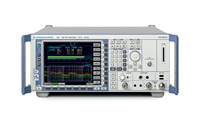EMI Test Receiver R&S ESU: fast and accurate interference measurements

Rohde & Schwarz, the market leader in EMC test and measurement, sets standards with he new R&S ESU product family. The CISPR16-1-1-compliant EMI Test Receiver R&S ESU meets all civil and military standards for electromagnetic interference measurements. The three models – the R&S ESU8, R&S ESU26 and R&S ESU40 with frequency ranges of 20 Hz to 8 GHz, 26.5 GHz and 40 GHz – feature a wide dynamic range combined with low inherent noise and low measurement uncertainty, which ensures high-quality test results. Each model is equipped with a second pulse-resistant RF input from 20 Hz to 1 GHz. The R&S ESU comes with integrated preselection, which is a must for standard-compliant measurements, and a switchable amplifier up to 3.6 GHz. Wide-ranging test functions such as configurable RF scan, realtime IF analysis and the new time-domain scan for quick overview measurements allow complex tests to be performed easily and conveniently. All detectors – peak, AV, quasi-peak, CISPR-AV, RMS as well as the CISPR-RMS detector proposed for standardization – are digitally implemented. Measurements are thus extremely stable and reproducible. The time-domain scan – which is available as a commercial solution in EMI test receivers for the first time – is a new method for overview measurements and is based on fast Fourier transform (FFT). Using this method to measure the EMI spectrum from 30 MHz to1 GHz and 9 kHz IF bandwidth is up to a hundred times faster than with a conventional scan. This results in higher throughput and lower costs per measurement. The R&S ESU-K53 time-domain scan is available as a separate option. Manual measurements continue to be a highly effective means of identifying, locating and suppressing sources of electromagnetic interference. For this purpose, the R&S ESU features a large, easy-to-read LC TFT display on which users can see all information at a glance. The measured values for the different detectors are displayed not only numerically but also in analog bargraphs. The influence of manipulations on the DUT can thus be immediately seen. The lower part of the screen shows either the complete RF interference spectrum with limit lines or – with the realtime IF analysis – the conditions around the set receiver frequency. The IF analysis in particular helps users to identify EMI and gives them an impression of the interference spectrum (ambient interference, for example) near the set measurement frequency. The EMI Test Receiver R&S ESU is available from Rohde & Schwarz.
